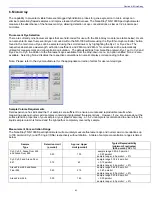
Section 3-General Operation
present on the measurement pedestals. The metal fiber optic fittings are made from 303 stainless steel and are resistant
to most common laboratory solvents (see “Solvent Compatibility” appendix). Note: Please do not use a squirt bottle to
apply diluted bleach.
Special Cleaning Requirements for Proteins
Proteins and solutions containing surfactants can “un-condition” the measurement pedestal surfaces so that the liquid
column does not form well with 1ul samples. If this occurs, “buff” the measurement pedestal surfaces by rubbing each
measurement surface aggressively with a dry laboratory wipe 30-40 times. This will “re-condition” the surface allowing the
liquid sample column to form. Alternatively, use the NanoDrop Pedestal Reconditioning Compound (PR-1) as a rapid
means of reconditioning the pedestals when the surface properties have been compromised and liquid columns break
during measurement. Additional information about the PR-1 kit may be found a
t
www.nanodrop.com.
Sample Size Requirements
Although sample size is not critical, it is essential that the liquid column be formed so that the gap between the upper and
lower measurement pedestals is bridged with sample.
Field experience indicates that the following volumes are sufficient to ensure reproducibility:
•
Aqueous solutions of nucleic acids: 1 ul
•
Purified protein: 2 ul
•
Bradford, BCA or Lowry assay: 2 ul
•
Microbial cell suspensions: 1-2 ul
It is best to use a precision pipettor (0-2 ul) with precision tips to assure that sufficient sample (1-2 ul) is used. Lower
precision pipettors (0-10 ul and larger) are not as good at delivering 1 ul volumes to the measurement pedestal. If you are
unsure about your sample characteristics or pipettor accuracy, a 2 ul sample is recommended.
Sample Carryover
Prevention of sample being retained on the ND-1000 Spectrophotometer’s measurement pedestals is easily addressed.
Simple wiping of the upper and lower measurement pedestal with a dry laboratory wipe is highly effective in eliminating
carryover for samples differing in concentration by as much as three orders of magnitude (see data at
www.nanodrop.com). This is possible since each measurement pedestal is in actuality a highly polished end of a fiber
optic cable. There are no cracks or crevices for residual sample to get trapped within.
Sample Homogeneity
Sampling from non-homogeneous solutions – particularly when using small volumes – can cause significant deviations in
the data generated using all measurement technologies including spectrophotometry. Genomic DNA, lambda DNA and
viscous solutions of highly concentrated nucleic acids are common examples known to the molecular biologist. Proteins
are subject to denaturation, precipitation, and aggregation and therefore may require special handling to ensure sample
homogeneity.
Effect of Evaporation and Solvents
Evaporation of the sample during the measurement cycle usually has just a minimal effect on absorbance readings and
may result in a 1-2% increase in sample concentration. This can be observed in the field by measuring the same sample
successively over time. Highly volatile solvents, such as hexane, will likely evaporate before the measurement can be
completed. Less volatile solvents such as DMSO can be used successfully.
Sample Recovery
One of the advantages of the sample retention system is that samples can be recovered from the upper and lower
measurement pedestals by extraction with a pipette.
Software Architecture and Features
Main Menu
With the sampling arm in the down position, start the NanoDrop
software by selecting the following path:
Start
Æ
Programs
Æ
NanoDrop
Æ
ND-1000 (version)
3-2










































